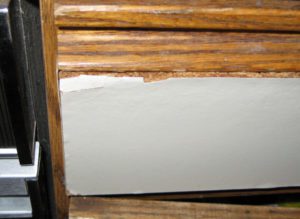Kitchen box material – what are we talking about here?
Few projects drain your budget like a kitchen remodel. Your preferred style doesn’t matter — whether you are going Shaker or modern or in between — with cabinet tabs ranging from $7,000 to $25,000 for an average kitchen, you want quality for your coin. One of your first cabinet decisions is whether to choose a cabinet box made from particleboard or from plywood.
Why the box matters
So why should the mostly hidden box be of concern? Because it is the backbone of your cabinets. It must be strong.
Particleboard or plywood?
Of the two popular choices for box construction, plywood and particleboard, which is better?
Here are a couple of hints: Cabinet manufacturers use plywood for the boxes of their upper-end cabinets and many cabinet-refacers are reluctant to reface particleboard boxes. Particleboard doesn’t quite measure up to plywood.
It comes down to weight and durability. Even the holes for the shelf pins hold up better in plywood.



Examples of particleboard cabinets that have either failed or started to de-laminate
On the plus side for particleboard, it is smoother and more consistent than plywood and less likely to warp. It’s also cheaper. But it is much heavier and more susceptible to moisture damage — and there is plenty of moisture in a kitchen. Some particleboard supporters argue that the modern product, sometimes referred to as “furniture board,” is made under higher pressure with stronger resin and is better than the old. But if it’s any indication, this material is still not used by manufacturers for their top-end cabinets.

High-quality 11-ply plywood, including veneer, is used in this custom-cabinet drawer
Plywood is stronger and more durable than particleboard. But not all plywood is alike. In fact, there can be huge variations in quality. Plywood can have gaps in plies, and all but the best stuff can warp.
These tips can help you check the quality of plywood cabinets:
- The wood should have many thin plies — at least 7-ply for ¾-inch plywood (including the veneer), but you can go as high as 13-ply.
- When you look along the edge of the plywood, you should not see any voids in the plies. And needless to say, if you see any warping in a sheet of plywood, it is not suitable for cabinetry.
Cabinet box hybrids
Some cabinetmakers use a hybrid of particleboard and plywood. The core is particleboard or medium density fiberboard (MDF), covered with a wood veneer. This product is virtually warp-free, but carries similar weight and moisture problems like particleboard.
All but the snootiest of cabinetmakers typically offer both particleboard and plywood products, but plywood can cost you about 12 percent more than particleboard on average — ranging from as little as 7 percent to as much as 20 percent higher. Weigh your budget and your needs carefully before you choose.
On a final thought: Another approach we started seeing is to combine plywood and particleboard cabinet boxes. Where plywood boxes would be used in areas of potential water damage, like around the sink, dishwasher, refrigerator and particleboard boxes in the rest of the kitchen. Once you put the doors and drawer fronts on the boxes you can’t really tell the difference.
And here’s a helpful video going over the various cabinet box materials: Most_used_cabinet_box_materials







